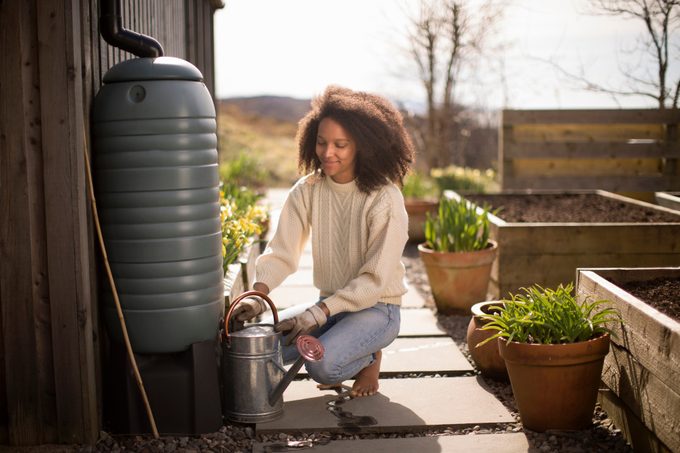Rain Barrel Basics: How to Get Started
Updated: Jun. 25, 2024
Learn how you can put excess rainwater to good use in your garden or landscaping by containing it in a rain barrel.
Our editors and experts handpick every product we feature. We may earn a commission from your purchases.
Rain barrels are containers designed to capture and hold rainwater for later use in gardens and landscaping. Using a rain barrel can lower your water bill, help reduce stormwater runoff and enhance the health of your local environment. Here’s what you need to know to get started.
Discover 15 ways to conserve water in the garden.
On This Page
Rain Barrel Benefits

Out in nature, a large amount of rain is absorbed directly back into the ground, replenishing the soil, and the rest either evaporates or is runoff that ends up in creeks, rivers, lakes or other bodies of water. But that amount drops significantly in more developed areas.
Rain barrels can help prevent stormwater from overwhelming storm sewers and lessen groundwater pollution and flooding during heavy rain events.
“A major benefit is having free water on-site and easy to access, while reducing how much water is running off,” says Laura Matter, a horticulturist for more than 40 years. Based in Seattle, Washington, Laura leads the Natural Yard Care program for Tilth Alliance, a nonprofit working with “farmers, gardeners and eaters to build a sustainable, healthy and equitable food future.”
As rainwater picks up pollutants on roofs and roadways, “excess water in storm drains can be a problem in sewers, which can be connected to surrounding water bodies,” Laura says.
Many cities and government agencies offer incentives for rain barrels (and other rain-harvesting tools) to encourage water conservation. Consult your local city, public utilities and water district websites for the latest on potential rebate programs or restrictions, as some states or counties have specific rules for collecting water.
Here’s what gardeners need to know about xeriscaping.
How to Collect Rainwater in Barrels

Rain barrels are typically positioned under a downspout to capture water from your roof. Depending on your climate, roof size and water needs, you may want to gather more water than an average 55-gallon rain barrel can hold. “That isn’t going to get you through the summer,” says Laura.
One option is to link several barrels in a chain that fills up in succession. For a large property, consider a tank or cistern.
You’ll want to check your roof material before setting up a rain barrel. Some materials, such as asphalt shingles, treated wood, copper, PVC or zinc panels can leach metals and toxic materials into the water. In those cases, look into other options, such as tanks that collect rain that hasn’t touched the roof.
Ways to Use the Water

Your saved rainwater can be used to irrigate trees, shrubs and flower beds; feed into a rain garden; or wash your home or car. Because roof water can contain particulates from birds, moss and roof tile materials, it’s not recommended to use it for drinking or for watering edible plants.
Rain Barrel Maintenance
Be sure to keep the filters clean and drain the container before freezing temperatures arrive if your barrel isn’t winter-proof.
How to Choose a Rain Barrel
In addition to sturdy construction and fittings that can withstand your local heat and cold extremes, experts recommend looking for a rain barrel that:
- has a filter to keep away bugs, especially mosquitoes.
- has a child- and animal-proof lid that closes firmly or locks.
- is made of food-safe materials.
- provides easy access to the water.
- has an overflow hose to keep excess water away from your home.
- has a spigot low on the barrel to limit water stagnation.
- can be elevated for gravity-fed irrigation or linked to other barrels if needed.
Rain Barrel Top Picks
50 Gallon Ivy Rain Barrel
![Ivy Blk Sunshine Glam Crop[87]](https://www.birdsandblooms.com/wp-content/uploads/2024/06/Ivy_blk_Sunshine_Glam_crop87-1.jpg?fit=680%2C995)
This sleek 50-gallon design made of recycled materials will fit in urban yards and easily connect to other barrels, and is opaque to discourage algae.
Good Ideas 90 Gallon Plastic Planter Rain Barrel

Holding 90 gallons, this plastic rain barrel from Good Ideas has an overflow-friendly top with a planter feature that’s the perfect setting for a plant.
65 Gallons Rainwater Urn

This teardrop-shaped rain barrel is made out of polyethylene, which is resistant to both chipping and UV light. Plus it comes with a 5-foot hose and holds 65 gallons of rainwater.
About the Expert
Seattle horticulturalist Laura Matter is the Natural Yard Care program director for Tilth Alliance. She has a bachelor’s degree in botany, ecology and plant physiology from the University of Washington.
Sources
- https://www.bluebarrelsystems.com/wp-content/uploads/2014/01/Runoff-in-Developed-Landscapes.png
- https://jacksontwpfranklinoh.gov/wp-content/uploads/2013/04/Rainwater_Guide1.pdf
- https://www.bluebarrelsystems.com/blog/environmental-benefits-of-rainwater-harvesting/
- https://cdc.gov/healthywater/drinking/private/rainwater-collection.html
- King County – Rainwater Harvesting for Outdoor Use


